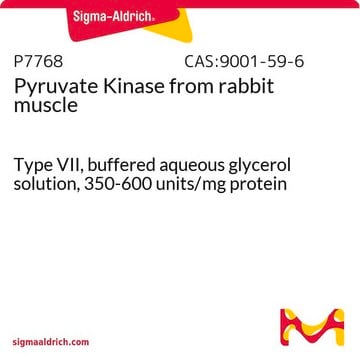If this product has an expiration or retest date, it will be shown on the Certificate of Analysis (COA, CofA). If there is no retest or expiration date listed on the product's COA, we do not have suitable stability data to determine a shelf life. For these products, the only date on the COA will be the release date; a retest, expiration, or use-by-date will not be displayed.
For all products, we recommend handling per defined conditions as printed in our product literature and website product descriptions. We recommend that products should be routinely inspected by customers to ensure they perform as expected.
For products without retest or expiration dates, our standard warranty of 1 year from the date of shipment is applicable.
For more information, please refer to the Product Dating Information document: https://www.sigmaaldrich.com/deepweb/assets/sigmaaldrich/marketing/global/documents/449/386/product-dating-information-mk.pdf
MAK072
Pyruvate Kinase Activity Assay Kit
sufficient for 100 colorimetric or fluorometric tests
About This Item
Recommended Products
usage
sufficient for 100 colorimetric or fluorometric tests
detection method
colorimetric
fluorometric
relevant disease(s)
hematological disorder; cancer
storage temp.
−20°C
General description
The Pyruvate Kinase Activity Assay Kit provides a simple and direct procedure for measuring pyruvate kinase activity in a variety of biological samples. Pyruvate concentration is determined by a coupled enzyme assay, which results in a colorimetric (570 nm)/ fluorometric (λex = 535/λem = 587 nm) product, proportional to the pyruvate present. One unit of pyruvate kinase is the amount of enzyme that will transfer a phosphate group from PEP to ADP to generate 1.0 μmole of pyruvate per minute at 25 °C.
Application
Suitability
Principle
replaced by
Signal Word
Danger
Hazard Statements
Precautionary Statements
Hazard Classifications
Aquatic Chronic 3 - Resp. Sens. 1 - Skin Sens. 1
Storage Class Code
10 - Combustible liquids
Choose from one of the most recent versions:
Certificates of Analysis (COA)
Don't see the Right Version?
If you require a particular version, you can look up a specific certificate by the Lot or Batch number.
Already Own This Product?
Find documentation for the products that you have recently purchased in the Document Library.
Customers Also Viewed
Articles
Warburg effect enhances glucose to lactate conversion in tumor cells, regardless of oxygen levels; impacting cancer metabolism since 1924.
Warburg effect enhances glucose to lactate conversion in tumor cells, regardless of oxygen levels; impacting cancer metabolism since 1924.
Warburg effect enhances glucose to lactate conversion in tumor cells, regardless of oxygen levels; impacting cancer metabolism since 1924.
Warburg effect enhances glucose to lactate conversion in tumor cells, regardless of oxygen levels; impacting cancer metabolism since 1924.
-
How can I determine the shelf life / expiration / retest date of this product?
1 answer-
Helpful?
-
-
How is shipping temperature determined? And how is it related to the product storage temperature?
1 answer-
Products may be shipped at a different temperature than the recommended long-term storage temperature. If the product quality is sensitive to short-term exposure to conditions other than the recommended long-term storage, it will be shipped on wet or dry-ice. If the product quality is NOT affected by short-term exposure to conditions other than the recommended long-term storage, it will be shipped at ambient temperature. As shipping routes are configured for minimum transit times, shipping at ambient temperature helps control shipping costs for our customers. For more information, please refer to the Storage and Transport Conditions document: https://www.sigmaaldrich.com/deepweb/assets/sigmaaldrich/marketing/global/documents/316/622/storage-transport-conditions-mk.pdf
Helpful?
-
-
Is this assay kit compatible to carry out the assay in Baker's yeast?
1 answer-
This kit may be used with variety of biological samples. However, it has not been tested with yeast samples, hence it cannot be guaranteed as suitable. Suitability would need to be validated by the end user.
Helpful?
-
-
What is the optimal cell quantity for conducting an assay with the Pyruvate Kinase Activity Assay Kit, particularly MAK072, and is this kit appropriate for use with red blood cells?
1 answer-
Optimization for the specific sample type is necessary. Typically, the protocol involves using 1 million cells or 10 mg of tissue suspended in 150-200 microliters of assay buffer.
Helpful?
-
-
请问一下这个是否适用于红细胞PKR检测,并且是否要破裂细胞,同时有酶标仪和九六孔板即可完成相关检测。
1 answer-
Theoretically, the Pyruvate Kinase (PK) Assay Kit should work with isolated red blood cells (RBC). However, RBC has not been purified or tested with this kit, therefore, no specific protocol recommendations can be made.
The end-user will have to determine the suitability using a reliable way to isolate RBC. Fresh whole blood coagulates which might negatively influence the isolation of RBC. Hence the isolation of RBC as well as the protocol for the PK Assay kit will have to be optimized for the intended application. This kit is labeled as being able to be used with blood as authors in the following citation used this kit for pyruvate kinase in plasma isolated from whole blood.
Please see the following publication below which may be beneficial for developing the appropriate method.
Nguyen Ba Vuong, Ha Van Quang, Bui Ngoc Linh Trang, Dao Hong Duong, Nguyen Linh Toan, Hoang Van Tong,
Association of PKLR gene copy number, expression levels and enzyme activity with 2,3,7,8-TCDD exposure in individuals exposed to Agent Orange/Dioxin in Vietnam,
Chemosphere, Volume 329, 2023, 138677, ISSN 0045-6535, https://doi.org/10.1016/j.chemosphere.2023.138677.Helpful?
-
Active Filters
Our team of scientists has experience in all areas of research including Life Science, Material Science, Chemical Synthesis, Chromatography, Analytical and many others.
Contact Technical Service






